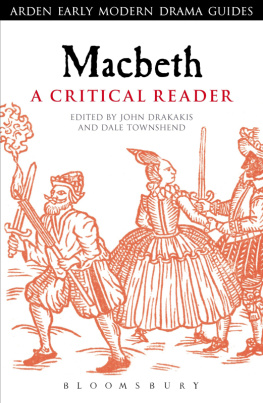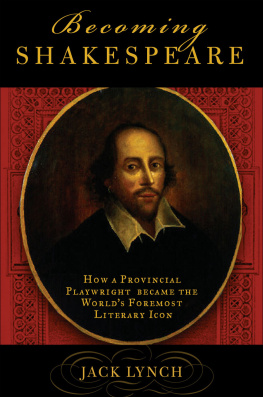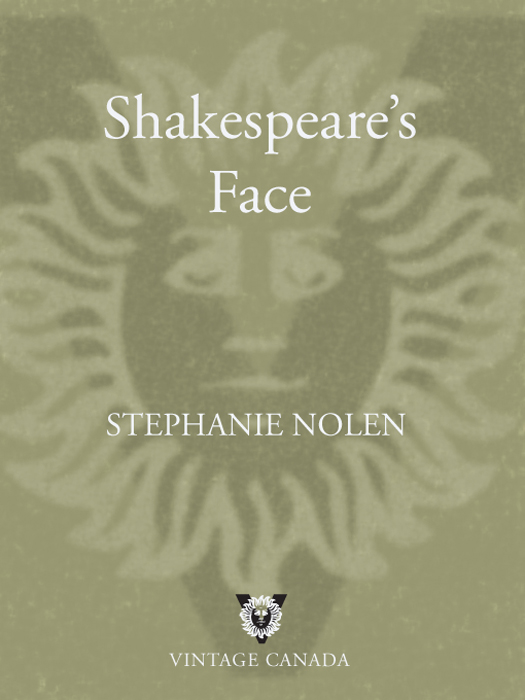PUBLISHED BY ALFRED A. KNOPF CANADA
Copyright 2002 Stephanie Nolen
Copyright 2002 the contributors
Foreword 2002 Rick Archbold
All rights reserved under International and Pan-American Copyright Conventions. Published in 2002 by Alfred A. Knopf Canada, a division of Random House of Canada Limited, Toronto. Distributed by Random House of Canada Limited, Toronto.
Knopf Canada and colophon are trademarks.
NATIONAL LIBRARY OF CANADA CATALOGUING IN PUBLICATION DATA
Nolen, Stephanie
Shakespeares face
eISBN: 978-0-307-36651-1
1. Shakespeare, William, 15641616Portraits.
I. Wells, Stanley W., 1930 . II. Title.
PR2929.N64 2002 822.33 C2002-900360-1
constitutes a continuation of the copyright page.
www.randomhouse.ca
v3.1
Contents
A Note to the Reader
Lloyd Sullivan, whose mother was Kathleen
Hales-Sanders, represents the family members
who own the Sanders portrait. They believe it
to have been painted by their ancestor John
Sanders (it is possible that Johns brother
Thomas, or another family member, was the
actual painter, if not the original owner). Lloyd
Sullivan has worked tirelessly to authenticate
the portrait, and his exhaustive research,
provided to the author, has been invaluable.
What I claim here is the right of every Shakespeare-lover who has ever lived to paint his own portrait of the man.
ANTHONY BURGESS, Shakespeare
Foreword
Like the painting that inspired it, this book can be read in different ways. One way is as a work of investigative journalism in which Stephanie Nolen goes behind the story she broke in May 2001 about a then-unknown portrait possibly of William Shakespeare. Her six chapters, which form the spine of the book, take us along on her voyage of discovery. As she notes, she is neither a Shakespeare scholar nor a trained art historian, but rather a curious layperson who attempts to unravel the mystery of the painting and to seek answers to the many questions it poses. From time to time, she calls on an expert to assist her in solving a particular puzzle or in separating fact from fiction.
Read another way, Shakespeares Face is a fascinating work of literary and art historical scholarship in which a distinguished group of experts from Canada, Great Britain and the United States bring all their wit and learning to bear on a very old picture. They look at the Sanders portrait as an artifact, as a work of art, as a cultural icon and as a fascinating window into Shakespeares world. Ive met only two of these scholars in person, but I like to imagine them gathered around the painting as I saw it when it went on display at the Art Gallery of Ontario, in Toronto, in the summer of 2001.
The portrait sits on a pedestal in the middle of a small gallery. The scholars form a circle around this enigmatic objectare some of them trying to catch its eye?each one with a different point of vantage. At first the room is quiet, as each of them looks for the clues that mean the most to her or him. One scholar moves up to look at the painting face to face. Another inspects the back of the panel under a magnifying glass. Still another seems to be as interested in his Collected Works of Shakespeare as in the picture. Finally one of them offers an opinion. Another chimes in. And soon the room is filled with animated discourse. (Involved in this conversation and yet separate from it is Stephanie Nolen, who is writing furiously in her notebook and missing not one crucial detail.) The conversation they might have had if they had met around the portrait is the one they now hold in the pages of this book.
But perhaps the most satisfying way of reading Shakespeares Face is as a historical detective story in which some of the evidence is four hundred years old, some is still warm and some may still turn up. In this version of the book the skills of all its writersten scholars and one journalistare needed: investigative reporting; art historical analysis; paleography; literary deduction; genealogy; cultural anthropology; scientific analysis; painstaking archival research, to name a few. All their skills combine in an attempt to answer the question that all of us must ask of the slightly naughty-looking fellow in the Sanders portrait: Are you Shakespeare, or arent you? Is yours the face of genius?
If your experience of reading Shakespeares Face is anything like mine has been as its editor, charged with bringing all these pieces together into what I hope makes for a coherent whole, then as you turn these pages, and move from one point of view to another, you will change your opinion time and again on its central question. In the process you will learn a great deal about a great many things, ranging from the forensic analysis of old works of art to the hidden messages in obscure Elizabethan poems. But most of all you will gain a new and more intimate sense of William Shakespeare.
However you read this book, you will always come back to Shakespeare and the extraordinary staying power of his genius. He is omnipresent in our world even if he comes from a place and time quite alien to our own. He is where we least expect him, including, some would argue, in a painted face on an old and somewhat battered oak panel that has gone unnoticed for most of its life since perhaps a fledgling player in Shakespeares company applied the paint, layer on layer on layer, until it formed a facea face of which one thing can be said for sure: it looked upon the same England that Shakespeare saw four centuries ago.
Rick Archbold
Toronto, Spring 2002
A Note on the Writers
Jonathan Bate (Scenes from the Birth of a Myth and the Death of a Dramatist) is King Alfred Professor of English Literature and Leverhulme Research Professor at the University of Liverpool. Among his books on Shakespeare are The Genius of Shakespeare (1997) and The Oxford Illustrated History of Shakespeare on Stage (2001). He is currently writing the volume on the Elizabethan period for the new Oxford history of English literature, of which he is also general editor. He is a regular reviewer for The Sunday Telegraph and The Times Literary Supplement. His reviews have also appeared in The New York Times and The Wall Street Journal.
Tarnya Cooper (A Painting with a Past) studied at the Courtauld Institute of Art and the University of Sussex, where she specialized in non-courtly English portraiture of the sixteenth and early seventeenth centuries. She earned her D. Phil. in the History of Art for her dissertation, Memento Mori Portraiture: Painting, Protestant Culture and Patronage by Middle Elites in England and Wales 15441630. She works as Assistant Curator of Art at University College, London, and is the art historical adviser to the exhibition on the world of Queen Elizabeth I at the National Maritime Museum, London, which will open in the spring of 2003. She is the author of a number of articles on Elizabethan portraiture.
Marjorie Garber (Looking the Part) is William R. Kenan Jr. Professor of English and Director of the Humanities Center, as well as the Chair of the Department of Visual and Environmental Studies and Director of the Carpenter Center for the Visual Arts at Harvard University. She also chairs an international organization, the Consortium of Humanities Centers and Institutes. The author of three books on Shakespeare,


















